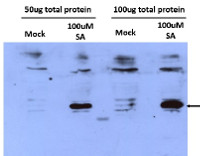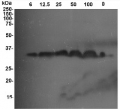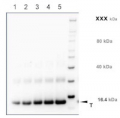1

Anti-PR-5 | Pathogenesis-related protein 5 (A.thaliana)
AS12 2373 | Clonality: Polyclonal | Host: Rabbit | Reactivity: Arabidopsis thaliana
- Product Info
-
Immunogen: KLH-conjugated synthetic peptide derived from Arabidopsis thaliana UniProt: P28493,TAIR:AT1G75040
The peptide is not found in other thautamin-like proteins.Host: Rabbit Clonality: Polyclonal Purity: Serum Format: Lyophilized Quantity: 50 µl Reconstitution: For reconstitution add 50 µl, of sterile water Storage: Store lyophilized/reconstituted at -20°C; once reconstituted make aliquots to avoid repeated freeze-thaw cycles. Please remember to spin the tubes briefly prior to opening them to avoid any losses that might occur from material adhering to the cap or sides of the tube. Tested applications: Western blot (WB) Recommended dilution: 1 : 10 000 (WB)
Expected | apparent MW: Propeptide 25.3 kD, processing aa 1-23, mature peptide 22.8 kD - Reactivity
-
Confirmed reactivity: Arabidopsis thaliana
Predicted reactivity: Arabidopsis thaliana - Application Examples
-

50 and 100 µg of total protein from Arabidopsis thaliana wild-type plants treated with water and salicylic acid (SA) analog BTH (Benzothiadiazole) were extracted with buffer containing 50 mM Tris-HCl pH 7.5, 150 mM NaCl, 10 mM MgCl2, 5 mM EDTA, 10% glycerol, 0.1% NP-40, 0.1% protease inhibitor cocktail . The proteins were denatured by boiling for 5 min were separated on 10% SDS-PAGE and blotted 30 min to PVDF using tank transfer. Blots were blocked with TBST containing 5% non-fat dry milk for 1h at room temperature (RT) with agitation. Blot was incubated in the primary antibody at a dilution of 1: 10 000 for for 4 h/RT with agitation in TBS-T. The antibody solution was decanted and the blot was rinsed briefly twice, then washed 3 times for 15 min each in TBS-T at RT with agitation. Blot was incubated in secondary antibody (anti-rabbit IgG horse radish peroxidase conjugated) diluted to 1:20 000 in for 1h at RT with agitation. The blot was washed as above and developed with Clarity MAX (Bio-RAD). Exposure time was 3 minutes.
Courtesy Ms. Ruiying Liu and Dr. Pradeep Kachroo, University of Kentucky, USA
Arabidopsis thaliana Col-0 treated with water (1) Col-0 treated with 0.5 mM SA (2), npr1-2 treated with water (3), npr1-2 treated with 0.5 mM SA (4). Samples were collected at 24 hours after treatment. 0.1g of total protein was collected from four-week-old plants. Protein extracted with 150 μL protein extraction buffer (50 mM Tris-HCl, pH 7.5, 150 mM NaCl, 5 mM EDTA, 0.1% Triton X-100, 0.2% Nonidet P-40, 1 mM PMSF, 1×PIC) and denatured with SDS at 70 ℃ for 10 min. 60 μg protein were separated on 4-12% SDS-PAGE and blotted 1h to nitrocellulose membrane using tank transfer. Blots were blocked with 5% non-fat dry milk in TBST for 1h at room temperature (RT) with agitation. Blot was incubated in the primary antibody at a dilution of 1: 1 000 overnight at 4 ℃ with agitation in TBST. The antibody solution was decanted, and the blot was rinsed briefly twice, then washed once for 15 min and 3 times for 5 min in TBS-T at RT with agitation. Blot was incubated in secondary antibody (anti-rabbit IgG horse radish peroxidase conjugated) diluted to 1:2500 in 5% non-fat dry milk in TBST for 1h at RT with agitation. The blot was washed as above and developed for 5 min with SuperSignalTM WEST Pico PLUS Chemiluminescent Substrate from Thermo Scientific. Exposure time was 60 seconds.
Courtesy Msc Min Li, University of South Carolina, USA - Background
-
Background: PR-5 (Pathogenesis-related protein 5) is involved in plant pathogen defence.
- Protocols
-
- Reviews:
-
This product doesn't have any reviews.
Accessories

AS07 208 | Clonality: Polyclonal | Host: Rabbit | Reactivity: N. benthamiana, N. clevilandii, N. tabacum, Phalenopsis, P.abies, S.lycopersicum, S. tuberosum, V. vinifera | compartment marker of vacuolar contents

AS10 687 | Clonality: Polyclonal | Host: Rabbit | Reactivity: A. thaliana, H. vulgare, N. bentamiana, S. oleracea, S. lycopersicum, T. aestivum, Z. mays, V. vinifera
50% discount on matching standard/positive control
AS10 687S PR-1 | Positive control/quantitation standard
Use promotional code: Stand50

